Tourism in the Dominican Republic - a legal guide - Pellerano ...
Tourism in the Dominican Republic - a legal guide - Pellerano ...
Tourism in the Dominican Republic - a legal guide - Pellerano ...
You also want an ePaper? Increase the reach of your titles
YUMPU automatically turns print PDFs into web optimized ePapers that Google loves.
participation. All poverty <strong>in</strong>dicators have likewise<br />
improved.<br />
The growth experienced by <strong>the</strong> Dom<strong>in</strong>ican economy<br />
dur<strong>in</strong>g <strong>the</strong> year 2000 captured <strong>the</strong> attention of <strong>the</strong><br />
<strong>in</strong>ternational community, be<strong>in</strong>g praised by <strong>in</strong>stitutions<br />
such as <strong>the</strong> International Monetary Fund and <strong>the</strong><br />
Economic Commission for Lat<strong>in</strong> America and <strong>the</strong><br />
Caribbean, which <strong>in</strong> its prelim<strong>in</strong>ary report for said year<br />
confirmed that <strong>the</strong> Dom<strong>in</strong>ican <strong>Republic</strong> showed <strong>the</strong><br />
highest growth rate of all Lat<strong>in</strong> American and Caribbean<br />
countries, and that this was <strong>the</strong> fifth consecutive year<br />
that <strong>the</strong> country had been break<strong>in</strong>g its annual growth<br />
record. Fur<strong>the</strong>rmore, dur<strong>in</strong>g <strong>the</strong> year 2001, <strong>in</strong> spite of<br />
adverse external and <strong>in</strong>ternal factors, <strong>the</strong> economy<br />
grew by 2.7%, a rate that was five times higher than<br />
<strong>the</strong> average growth rate <strong>in</strong> Lat<strong>in</strong> America.<br />
POLITICAL SYSTEM<br />
The Constitution of <strong>the</strong> Dom<strong>in</strong>ican <strong>Republic</strong> def<strong>in</strong>es<br />
<strong>the</strong> government system as be<strong>in</strong>g democratic, republican<br />
and presidential. The exercise of power is divided<br />
among three <strong>in</strong>dependent branches: executive,<br />
legislative and judicial.<br />
Executive Branch<br />
The Executive Power is exercised by <strong>the</strong> President<br />
of <strong>the</strong> <strong>Republic</strong>, who is elected through direct vote,<br />
toge<strong>the</strong>r with <strong>the</strong> Vice-president, for four-year-periods,<br />
but without possibility of re-election for consecutive<br />
periods s<strong>in</strong>ce <strong>the</strong> last amendment to <strong>the</strong> Constitution <strong>in</strong><br />
1994. The President is <strong>the</strong> Head of State, Government<br />
and Public Adm<strong>in</strong>istration, as well as <strong>the</strong> Commander <strong>in</strong><br />
Chief of <strong>the</strong> Armed Forces, and is assisted by a cab<strong>in</strong>et<br />
of m<strong>in</strong>isters ("Secretarios de Estado") designated by<br />
him.<br />
S<strong>in</strong>ce August 2000 <strong>the</strong> President of <strong>the</strong> <strong>Republic</strong> is<br />
Mr. Hipolito Mejia, and <strong>the</strong> Vice-president is Mrs.<br />
Milagros Ortiz Bosch, of Partido Revolucionario<br />
Dom<strong>in</strong>icano (PRD). Due to <strong>the</strong> results of <strong>the</strong> poll held <strong>in</strong><br />
May 2000, which gave President Mejia and Vicepresident<br />
Ortiz Bosch a victory that was very short of<br />
reach<strong>in</strong>g <strong>the</strong> required 50%, <strong>the</strong> opposition waived a<br />
second poll, and <strong>the</strong>y were proclaimed w<strong>in</strong>ners of <strong>the</strong><br />
2000 election. The next presidential elections will take<br />
place <strong>in</strong> May 2004.<br />
Legislative Branch<br />
The Legislative Power is <strong>in</strong>vested <strong>in</strong> <strong>the</strong> National<br />
Congress, composed by two chambers: <strong>the</strong> Senate,<br />
PELLERANO & HERRERA<br />
ATTORNEYS AT LAW<br />
composed of 32 members, and <strong>the</strong> Chamber of<br />
Deputies, which at <strong>the</strong> moment is composed of 150<br />
members. The Dom<strong>in</strong>ican <strong>Republic</strong> is politically divided<br />
<strong>in</strong>to thirty-one prov<strong>in</strong>ces and <strong>the</strong> National District,<br />
where <strong>the</strong> capital is located, and each is entitled to<br />
elect one senator, and one deputy for every 50,000<br />
<strong>in</strong>habitants plus fraction exceed<strong>in</strong>g 25,000.<br />
The members of both chambers are elected by<br />
each prov<strong>in</strong>ce through direct majority vote for fouryear-periods.<br />
S<strong>in</strong>ce 1994 legislative elections take place<br />
separately from presidential elections.<br />
S<strong>in</strong>ce <strong>the</strong> last elections <strong>in</strong> May 2002, congressional<br />
representation of <strong>the</strong> different political parties is<br />
distributed as follows: at <strong>the</strong> Senate, thirty senators for<br />
Partido Revolucionario Dom<strong>in</strong>icano (PRD), one senator<br />
for Partido de la Liberacion Dom<strong>in</strong>icano (PLD), and one<br />
senator for Partido Reformista Social Cristiano (PRSC);<br />
at <strong>the</strong> Chamber of Deputies, 72 deputies for PRD, 40<br />
deputies for PLD and 38 deputies for PRSC.<br />
The next legislative elections will take place <strong>in</strong> <strong>the</strong><br />
year 2006.<br />
Judicial Branch<br />
The Judicial Power is headed by <strong>the</strong> Supreme Court<br />
of Justice, which apart from work<strong>in</strong>g as an appeals<br />
court for all judgments rendered by judicial courts,<br />
supervises all judges <strong>in</strong> <strong>the</strong> Dom<strong>in</strong>ican territory. It is<br />
formed of n<strong>in</strong>e judges designated by <strong>the</strong> National<br />
Council of Magistrates, an <strong>in</strong>stitution created by <strong>the</strong><br />
Constitutional reform of 1994 to ensure <strong>the</strong><br />
<strong>in</strong>dependence of <strong>the</strong> judicial branch.<br />
ECONOMY<br />
Economic evolution and prospects<br />
After <strong>the</strong> adjustment process <strong>in</strong>itiated at <strong>the</strong><br />
beg<strong>in</strong>n<strong>in</strong>g of <strong>the</strong> n<strong>in</strong>eties, <strong>the</strong> growth perspectives for<br />
<strong>the</strong> Dom<strong>in</strong>ican <strong>Republic</strong> are still strong. Between 1992-<br />
2000, <strong>the</strong> average annual growth was higher than 6%,<br />
and <strong>in</strong> <strong>the</strong> year 2001, <strong>the</strong> economy grew by 2.7% <strong>in</strong><br />
spite of <strong>the</strong> adverse <strong>in</strong>ternational environment. These<br />
numbers place <strong>the</strong> Dom<strong>in</strong>ican <strong>Republic</strong> as <strong>the</strong> fastest<br />
grow<strong>in</strong>g economy <strong>in</strong> Lat<strong>in</strong> America.<br />
Free trade zones and sectors like tourism,<br />
telecommunications and construction, have been <strong>the</strong><br />
ma<strong>in</strong> sources of economic development, with yearly<br />
growth rates higher than 10%.<br />
11


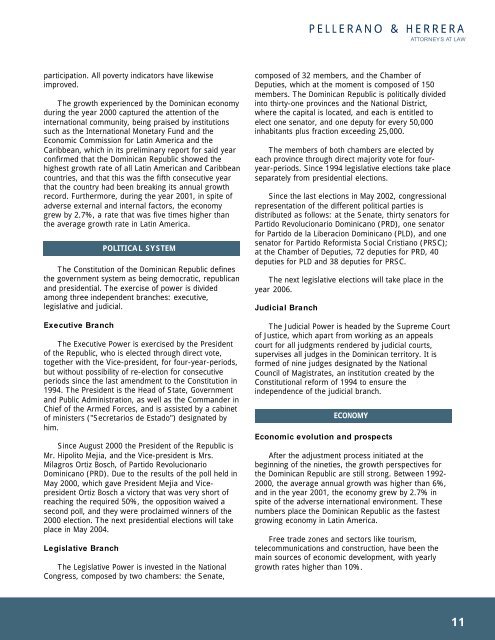
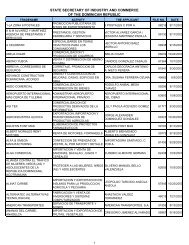

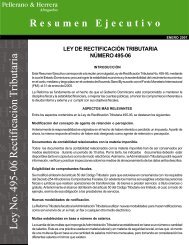
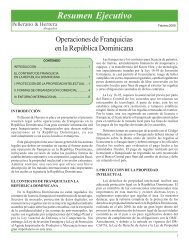

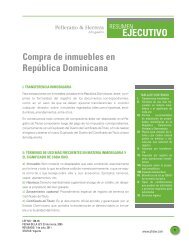
![[561] marca [730] solicitante 0553702 18/08/2005 01 dtp (deno](https://img.yumpu.com/11799286/1/190x245/561-marca-730-solicitante-0553702-18-08-2005-01-dtp-deno.jpg?quality=85)

![[210] expediente [220] sol fecha](https://img.yumpu.com/7098888/1/190x245/210-expediente-220-sol-fecha.jpg?quality=85)

![[561] marca [730] solicitante 0543593 08/07/2005 01 potafos](https://img.yumpu.com/3864072/1/190x245/561-marca-730-solicitante-0543593-08-07-2005-01-potafos.jpg?quality=85)